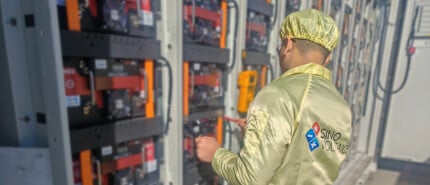The following article is an extract of our recent webinar: ‘Quality Risks of New PV Cell Technologies TOPCon and HJT’. If you like to watch the full Webinar, watch the recording here.

Introduction
The rapid and often simultaneous adoption of new technologies heightens the overall quality risk. Heterojunction and TOPCon PV technologies have caught the industry with a storm. More and more manufacturers are embarking on these for various reasons, including industry peer pressure. While these technologies offer a better limiting efficiency there are still problems to be investigated. Scientists and manufacturers themselves are still in the midst of getting acquainted with the peculiarities and potential risks of these technologies.
This is obvious from Figure 1 below: “Observations during Quality Inspection: the industry is still learning.” It shows the observations of Sinovoltaics quality engineers performing inspections at different workshops of the same manufacturer. It shows average pre-lamination rework rates at different production facilities during quality inspections throughout 2022, and the first quarter of 2023.
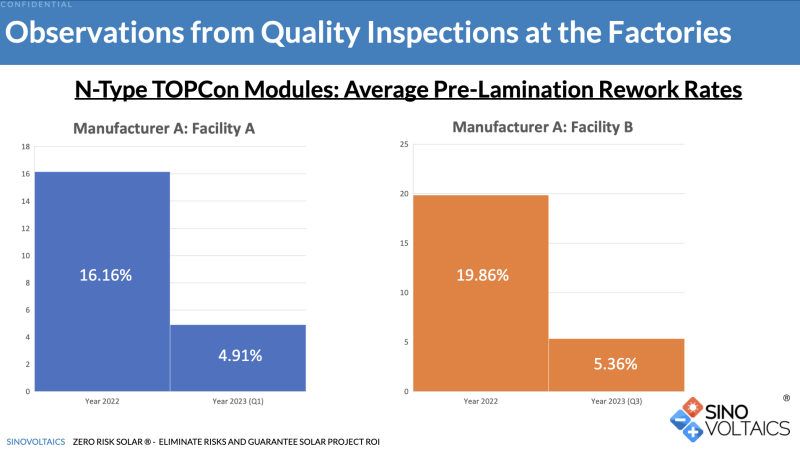 Figure 1: The industry is still learning
Figure 1: The industry is still learning
For facility A, the average rework rate was 16.16% in 2022, with a peak rate of 21.36%, and the lowest at 13.85%. It dropped to an average of 4.91% in the first three months of 2023, with the lowest actually at only 0.82%. Similar patterns can be observed with the data for facility B shown on the right side of Figure 1. Thus, in both cases, the initial average pre-lamination rework rates were almost threefold of the average rework rates in the first quarter of the year 2023.
This clearly points to a learning process and increasing understanding of TOPCon quality issues and their mitigation.
The reworked modules showed a variety of defects, (Figures 2 and 3) but the most prominent ones were strong striation rings, micro-cracks, and cell string faults as detected by Sinovoltaics proprietary software SELMA (Sinovoltaics EL Mass Analysis).
Performing 100% EL image analysis, SELMA has provided important insights and a grasp of the extent of quality issues that need to be addressed. The following figure shows some of the most observed quality defects when inspecting TOPCon modules.
 Figure 2: Observed Defects
Figure 2: Observed Defects
There is a very significant increase in defects compared to modules using P-type Passivation Emitter Rear Contact Cell (PERC) cells, for example. In addition to micro-cracks, there is a large increase in the severity of grid-finger breaks and mild to very strong striation ring patterns (a wafer manufacturing-induced defect triggered by fluctuating crystal silicon ingot growth rates during the Czochralski Process) and wafer.
Then there are also mixed cells or chess-board patterns in TopCon modules which result from minority carriers of different lifetimes.
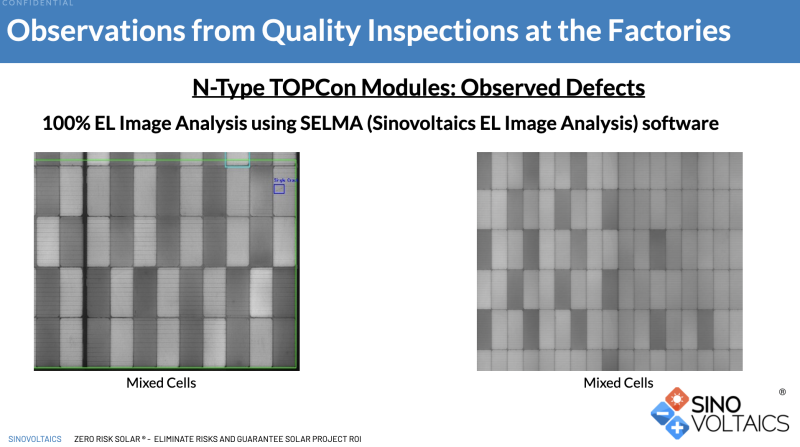 Figure 3: N-type Topcon modules
Figure 3: N-type Topcon modules
Newer technologies like perovskites promise a higher limiting efficiency but have a problem of stability. A real comparison must involve the stability property also. The next figure is a graph published by Marius Peters in 2019, showing the tradeoff between efficiency on the y-axis and degradation rate on the x-axis. (Figure 4).
 Figure 4: Stability Vs Efficiency Tradeoff
Figure 4: Stability Vs Efficiency Tradeoff
Assuming a standard silicon panel running at 20%, a perovskite module available with the stability that was reported at that time had to be 33% efficient to achieve the same levelized cost of electricity (LCOE) rates. We need significantly higher efficiency to compensate for poor stability. In other words, poor stability comes at a high price. And if we look at residential solar where the insulation costs are quite high that would actually mean if you had a 3% degradation rate your module should come free to be comparable. Or even worse, you pay money for people to take your modules in order to achieve the same LCOE.
In a nutshell, stability is extremely important in order to reduce LCOE, even for crystalline silicon. If we can reduce the degradation rate it'll reduce the LCOE.
Potential Induced Degradation (PID)
 Figure 5: PID Failures year wise
Figure 5: PID Failures year wise
Many of us might say PID was a big problem maybe five years ago, but it's no longer an issue. However, if we look at reporting data from, PVEL (an independent lab of the downstream solar industry) then 2021 was the worst year on record for PID. Last year, 2022, was not that much better as elaborated by Professor Bram Hoex from the University of New South Wales (UNSW) (Figure 5).
So, PID is still there, particularly because we are moving to bifacial solar cells, which make the rear more susceptible for PID. So, testing for PID vulnerability, and treating against it is important. And for economic reasons, it is much wiser to do it at the cell level.
There are three types of potential induced degradation:
- The shunting type
- The polarization type, and
- The corrosion type
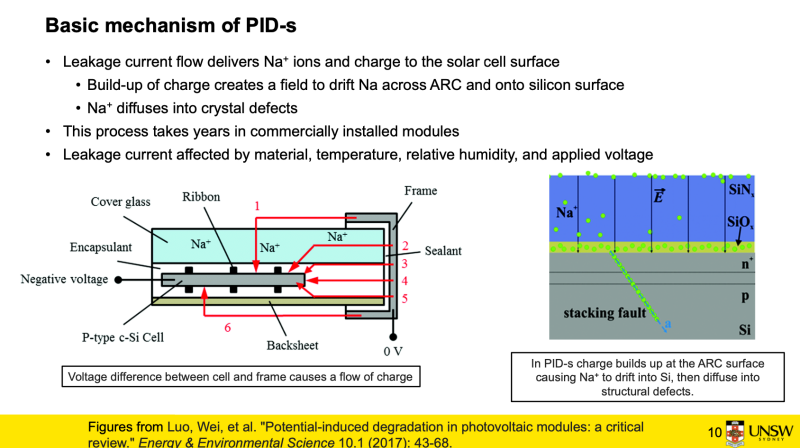 Figure 6: Basic PID Buildup Mechanism
Figure 6: Basic PID Buildup Mechanism
Here, we will predominantly focus on the shunting type. What does the shunting type PID result in? It's basically a drop in fill factor due to a decrease in the shunt resistance going down which results in a power drop. Our current understanding of PID is that it is related to the transport of sodium from the glass to the solar cell passing through the Antireflection coating and ending up in silicon faults. (Figure 6). That makes the shunt path.
The leakage current depends on a number of factors including manufacturing defects, applied voltage, humidity, and temperature. So, PID develops faster in higher relative humidity and higher temperature. For example, PID is a lot quicker in Singapore compared to the Netherlands. Higher applied voltage accelerates it as well. Now this is not a quick process. It takes years in commercially installed modules, and hence, is not likely to become visible in the first warranty period. In outdoor testing also it would take very long to appear.
 Figure 7: Basic PID test setup
Figure 7: Basic PID test setup
A special test setup is needed for PID testing in any reasonable time frame. One such system was developed at UNSW (Figure 7) which could give a result in 200 hours instead of years. Testing is possible at the module level and the cell level. At the cell level, the test took about 100 hours to complete.
But that was 100 hours for one data point only! How much time would be needed for a reasonable amount of statistically useful data? So, Professor Hoex’s team at UNSW went further and modified the test setup by replacing the EVA with a salt-enriched hybrid polymer consisting of 55% cellulose and 45% polyester.
See Figure 8: this hybrid polymer is soaked with sodium fluoride to avoid the step that the sodium had to move from the glass to the cell. The sodium path now being much shorter and faster the PID process is speeded up reaching the maximum power loss in a matter of minutes, say 12 minutes! That made it quicker by another hundred times.
 Figure 8: PID Build-up Mechanics
Figure 8: PID Build-up Mechanics
The engineers at UNSW went further and noted that potential distribution was not really uniform across the area. So, they included an additional conductive rubber sheet in order to harmonize the voltage.
The power loss shown by this accelerated test is higher than the actual value, but that is not really important. The test can quickly identify PID-prone cells from those which do not suffer from PID.
The accelerated test also made it possible to notice recovery or self-healing trends in PID, something that is still being investigated.
Because the cells are accessible, they can be subjected to lock-in thermography. Using this technique, shunts formed by the salt were observed and were seen to disappear after a few hours. Figure 9.
 Figure 9: Self healing
Figure 9: Self healing
Damp Heat Failures- Heterojunction and TOPCon
Significant failures were observed in Heterojunction and TOPCon solar cells using a glass back sheet. Interesting modes of failure, some not found in PERC, were observed which were not detectable by tests developed for PERC. Figure 11,12. Efficiency loss of as high as 22.5% was observed by the UNSW team.
 Figure 10: Failure in HJT glass-backsheet modules
Figure 10: Failure in HJT glass-backsheet modules
They described four types of defects. Extensive experimentation revealed that each needed different tests to detect and a treatment to avoid.
Type one is characterized by very localized areas of high recombination showing up as dark patches in both electroluminescence (EL) and photoluminescence (PL). Extensive research indicated that this failure mode was related to the soldering flux that had a strong reaction with either the silver paste or the ITO (Indium-Tin-Oxide). Super-clean cells will not show this type of failure.
 Figure 11: Damp-Heat failure Modes in Topcon and HJT
Figure 11: Damp-Heat failure Modes in Topcon and HJT
Type two and type three are actually similar. They show up particularly well in EL spreading out from the interconnection. These can actually result from an almost dead solar cell between the busbars.
In the fourth type of failure mode where there is significant darkening again at the lines of the busbars is where we have the interconnection. This model is the result of a chemical reaction of the paste with acetic acid.
The cell-level testing mode is about one hour or an order of magnitude quicker than the module-level testing. The unique testing at UNSW will allow customers to quickly identify if their bill of materials could result in these issues.
Sodium
In a very recent paper by EPFL, (École polytechnique fédérale de Lausanne) they showed significant degradation of heterojunction solar cells which was attributed to sodium. A striking observation from TNO Netherlands (Nederlandse Organisatie voor Toegepast Natuurwetenschappelijk Onderzoek (TNO; English: Dutch Organization for Applied Scientific Research) is an independent research organization in the Netherlands that focuses on applied science) showed degradation of TOPCon contacts: no failure when the front was just covered by EVA but when they put a glass on the EVA, which of course, is standard assembly material when manufacturing a crystalline-silicon module, there was a significant degradation. Similarly, other research institutes also showed potential reliability concerns with Heterojunction and TOPCon.
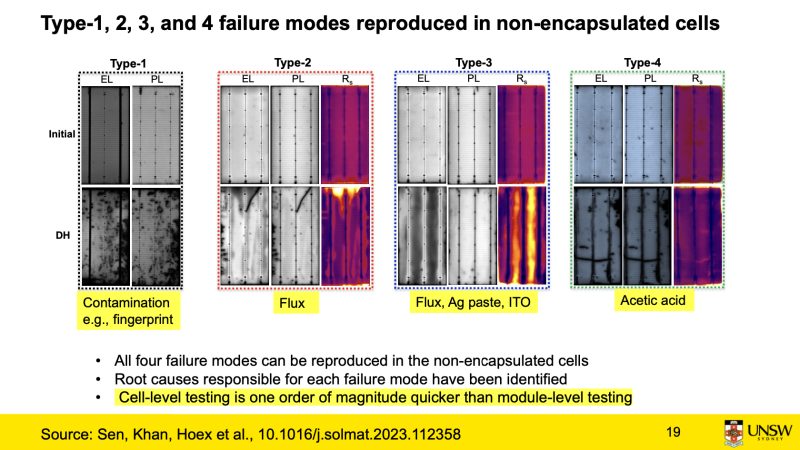 Figure 12: Type-1, 2, 3, and 4 failure modes reproduced in non-encapsulated cells
Figure 12: Type-1, 2, 3, and 4 failure modes reproduced in non-encapsulated cells
For Heterojunction cells, sodium was pinpointed as the likely candidate although TNO researchers suspected acetic acid. The study of the sodium effect is anyway very important as it is quite a common contaminant, being eight grams per kilogram for typical solar lime glass. Even white EVA and POE have significant amounts of sodium (Figure 13).
 Figure 13: Sodium contained in encapsulating materials
Figure 13: Sodium contained in encapsulating materials
Under UNSW‘s testing, sodium is transported to the sample under high voltage as for standard PID, but during operation actually more sodium will get to the cell. An interesting theory postulated by EPFL is that water gets into the module reacting with the glass and then releasing sodium in that way providing a lot of additional sodium to wreak havoc to the solar cell. This applies to PERC as well.
In one experiment UNSW exposed three types of solar cells to sodium: Bifacial TOPCon cells, Heterojunction cells, and PERC cells. TOPCon was found to be not very sensitive at the rear, but at the front, with up to 75% degradation.
In HJT, both front and rear are susceptible, giving a degradation of about 50%. In contrast, the PERC cell is quite stable with an efficiency reduction of under 10% mainly on the rear side.
 Figure 14:Comparison- damp Heat Effect
Figure 14:Comparison- damp Heat Effect
UNSW claims that they have developed viable solutions to protect against the above four failure modes-Type 1 to Type 4, at least for the heterojunction cells.
Stability-PERC Vs HJT/TOPCON
Higher efficiency stuff will be inherently more sensitive to impurities. So currently, that gives an apparent advantage to PERC. But as these new technologies mature, things may change.




